Financial meltdown that took place in the year 2008 had sent shivers down the spine in the global markets. And as such many nations in a bid to support their economies and help it revive once again, offered stimulus packages by introducing various tax breaks for the industry, injected money supply in the banking system to ease the liquidity situation, easy availability to credit, etc. However, the easy money policy followed by the developed countries, like the United States of America (USA) for a prolonged time period led to excessive money supply in the system and that too at near zero interest rates. However, these steroids (stimulus packages) did not result in revival of the economy in its real terms (by increasing production of goods) and also couldn't create jobs for millions of jobless citizens. Thus the aftershocks of one of the deadliest recessions in the known history of 2008 crisis look far from over.
Yes, we did witness an upsurge in the equity markets in the last couple of years, but prudent thinking reveals that it was merely a relief rally effected by bailout packages. And even today, the world's largest economy - the U.S. is displaying more reliance on a paper economy, as the president Obama led democratic Government is persuading the Republicans for an increase in the U.S. debt ceiling limit (which is presently at staggering USD 14.3 trillion. Realisation just doesn't seem to be dawn that "too much of anything is bad", which can get the world's largest economy into a situation of debt-overhang in the long-term.
What is debt ceiling?
To simply put, debt ceiling means a limit set by law on the amount that a Government can borrow to pay its obligation and to fund various activities.
Debt ceiling deadlock in US
In past 71 years the U.S. Congress has raised the debt ceiling 102 times. Then why does an issue which has been routinely encountered is making the U.S. government work overnight this time? Well, this is because, in the past we have almost never come across such a situation where two political parties have been fighting over raising a debt ceiling (because a rule which took effect from 1979 allowed the House of Representatives to automatically raise the limit of debt ceiling in accordance to the level of budget requirement). But lately, the rule has been altered.
Get debt go!!
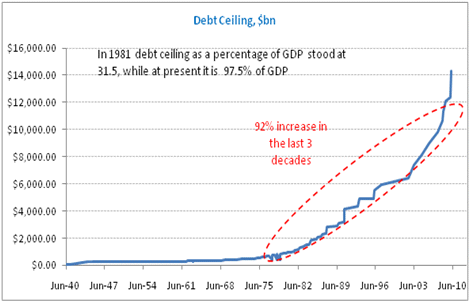
(Source:whitehouse.gov)
The chart above reveals that the increase in the U.S. debt ceiling has been rather aggressive and absurd in last the 11 years, immaterial of the fact whether the Democrats or the Republicans were in power. From USD 999.8 billion in September 1980, the U.S. debt ceiling has shot up to USD 14,294 billion so far - which is an whopping 92% increase whereby the present U.S. debt ceiling is at 97.5% of its GDP.
Big fat U.S. debt ceiling
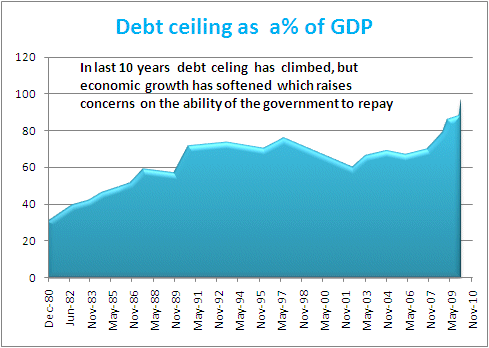
(Source:whitehouse.gov)
Mounting debt- Mounting problems
Today, in order to preclude from a case of sovereign default and ratings being downgraded, the U.S. economy is once again forced to increase its debt ceiling limit, which in the long-term multiplies there problems rather than find solutions. At present the U.S economic growth rate is quite dismaying, unemployment rate is high - and all this may also elevate chances of shivers being experienced by equity markets across the globe, because equity markets will be asking the question - "can the U.S service the bloating debt ceiling limit?"
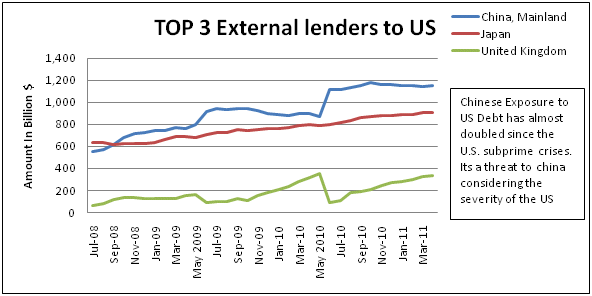
(Source:whitehouse.gov)
IMF estimates that this year, the U.S. will run the largest budget deficit US may have a shortfall of around 10.8% this year. President Obama has already proposed to cut spending by USD 3,000 billion and raise taxes by USD 1,000 billion in next 10 years. The Prime challenge for the U.S. is to reduce debt and budgetary deficits, but it may find it difficult to bridge the gap and reduce the leverage. Latest data published by Federal Reserve points out a slower growth in 8 out of 12 regions of Fed. If austerity plan proposed by the President Obama is implemented, it would provide no or very limited rescue as it would become increasingly difficult to achieve higher growth numbers as lesser government spending means lesser economic activity which will translate in lesser wages but in a scenario where taxes will stay high. In the wake of economic and political uncertainties, masses will try to save more which will further deteriorate the possibility of organic growth coming back to life.
The Impact on global economy
If the U.S. once again continues to follow the exuberant path of increasing debt, it may fund its various programs and repay its immediate obligations, but the long-term impact would be rather disastrous. Yes, short-term measures would act as pain reliefs but the long-term ailment still remains due to bloating debt and stumpy economic growth.
At present rating agencies such as Standard & Poor (S & P) has already warned the U.S. that it would slash its golden "AAA" rating if it does not come out with a concrete solution to deal with the ever mounting debt. Moreover, any rating down grade stands a threat to equity as well as bond markets, as the a contagion may be spread since investors in the U.S. may start squaring their positions in the equity markets in order to repay losses made in the U.S. Also with persisting Euro zone debt crisis, the nervousness may further grip and may not be able to absorb the investment demand of the bond market.
But after the immediate knee-jerk selling in most equity markets around the world, we may witness Foreign Institutional Investors (FIIs) turning their head towards the Asian economies. But they would be watchful on export oriented economies such as China and Japan (as they collectively hold more than USD 2,000 billion of total US Debt) as this may destructive for the respective country's reserves as well foreign exchange earnings. At present Japan's sovereign debt has been cut to AA- (from AA in February 2011), and thus given the fact that it is an export oriented economy, if it doesn't get traction from its export market, it will find it difficult to cut its long term debt.

(Source: PRC General Administration of Customs, China's Customs Statistics)
Impact on Asset Classes
Currencies:
The world has been bearish on dollar in the first half of 2011. If the U.S. debt deadlock remains unaddressed or is handled poorly then appetite for risk assets will drastically go down and despite the weak fundamentals dollar may initially rise as a kneejerk reaction. But in the long run due to weak fundamentals, dollar may witness losing its strength which would pose a threat to export driven economies such as China, Taiwan, Brazil, Mexico to name a few and these nations will be apprehensive of sharply falling dollar. Brazil has recently has taken some regulatory steps to curb the rise of domestic currency against the dollar. It now requires banks to make a zero interest bearing deposit worth the 60% of the value of their short dollar position, which means betting against the upward movement of dollar.
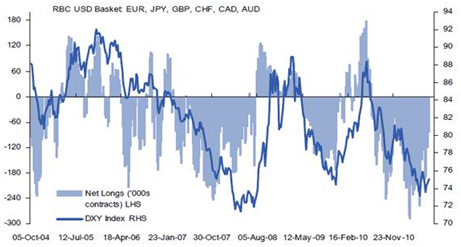
(Source: Euromoney FX,RBC Capital Markets, CFTC, Bloomberg)
(DXY is a dollar index which measures the performance of dollar vis-à-vis performance of some major currencies of the world.)
So far the chart above depicts that that extreme swings in the sentiment have rarely been rewarding. Net longs indicate that broadly people are bullish about the movement of the U.S. dollar. However, we need to wait and watch how the dollar index reacts to the net short positions this time around.
Equities:
US and other Developed Market Equities:
Roller coaster ride for S&P 500 Index
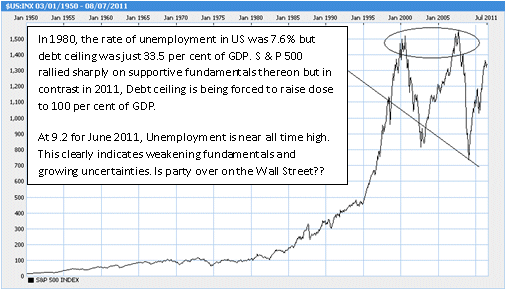
(Source: msn.com online charting tool)
As mentioned earlier if the U.S. debt ceiling limit is increased, equity markets in the U.S. may display an immediate upsurge. But the long-term question would still remain i.e. can they service their increase debt ceiling limit in the long-term and preclude sovereign debt crisis from happening. Moreover, with the following factors to be disappointing equity markets would remain under a nervous grip.
- Dismaying economic growth rate
- High debt to GDP ratio
- High unemployment rate-At present it stands at 9.2%
- Greater percentage of aging population
- Leveraged balance sheets of most corporates
Impact on Emerging Market Equities
A increase in the U.S. debt ceiling limit may refresh the bulls in the emerging markets. But on the other hand not increasing the same may have an immediate contagion of nervous sentiments spreading to emerging equity markets.
However having said that, in the long-term FIIs would turn their heads towards these markets (baring the export oriented ones) due to luring growth, prudent policy measures, strong consumption story and lower debt to GDP ratio.
Bond Markets:
Failure to raise the debt ceiling or any rating downgrade would result in higher interest payments in the long run. It may also impact the demand for US treasuries as many pension funds, by mandate, may not be able to invest in them. This may further trigger the upward revision in the interest rates. Value of long term bonds may fall sharply.
Commodities:
In the time of uncertainty investors, traders would always flock their way to safe heavens. In fact, post Lehman Brother bankruptcy (as well as the debt overhang situation in the Euro zone), gold has been frequently hitting new highs, and we believe would continue to maintain its northward journey as long as global economic turmoil continues.
Moreover, if dollar weakens due to failure of debt ceiling limit being increased, the northward trajectory would be clearly paved for the precious yellow metal.
At PersonalFN, we recommend that you should have a minimum of 5%-10% allocation to gold. Invest in gold with a long term perspective with a time horizon of 10 to 20 years.
The verdict:
We believe while the uncertainty prevails in the global economy, one needs to be cautious while investing and rather have a staggered approach while investing in equities. Indian equity markets look fairly robust and less susceptible to negative news from the U.S. as FIIs in the long-run would exude confidence here due to robust economic fundamentals our country have to offer.
But while investing in equities we think diversification benefit provided by mutual funds can help to reduce risk (however one needs to stay away from U.S. or Euro oriented offshore funds in such a scenario). While investing in equity mutual funds it would be advisable to adopt the SIP (Systematic Investment Plan) mode of investing as this will help you to manage the volatility of the equity markets well (through rupee-cost averaging) and also provide your investments with the power of compounding.
At current rate of interest fixed income instrument also are an attractive investment proposition, as rates are nearing the peak out levels. At present 1 yr Bank FDs are offering interest in the range of 7.25% - 9.25% p.a.
On the other hand, Gold despite new highs may continue to remain bold in the light of the global economic turmoil and thus shield your portfolio from risk and thus also deems inclusion in one's investment portfolio.
Add Comments
| Comments |
newyear@adcipare.com
Aug 19, 2011
I really appreciate free, succinct, reliable data like this. |
jaros@pasiekajaros.pl
Aug 19, 2011
Never would have thunk I would find this so indefeasible. |
1